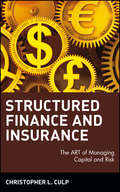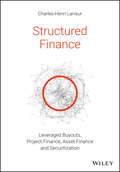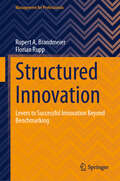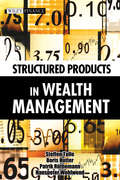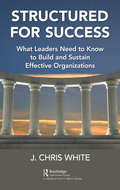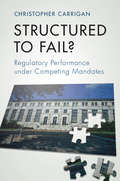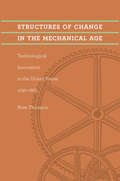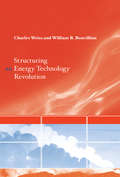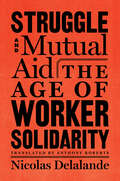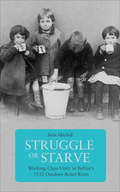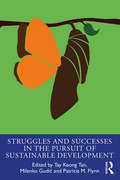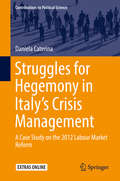- Table View
- List View
Structured Finance and Insurance
by Christopher L. CulpPraise for Structured Finance & Insurance"More and more each year, the modern corporation must decide what risks to keep and what risks to shed to remain competitive and to maximize its value for the capital employed. Culp explains the theory and practice of risk transfer through either balance sheet mechanism such as structured finance, derivative transactions, or insurance. Equity is expensive and risk transfer is expensive. As understanding grows, and, as a result, costs continue to fall, ART will continue to replace equity as the means to cushion knowable risks. This book enhances our understanding of ART."--Myron S. Scholes, Frank E. Buck Professor of Finance, Emeritus, Graduate School of Business, Stanford University"A must-read for everyone offering structured finance as a business, and arguably even more valuable to any one expected to pay for such service."--Norbert Johanning, Managing Director, DaimlerChrysler Financial Services"Culp's latest book provides a comprehensive account of the most important financing and risk management innovations in both insurance and capital markets. And it does so by fitting these innovative solutions and products into a single, unified theory of financial markets that integrates the once largely separate disciplines of insurance and risk management with the current theory and practice of corporate finance."--Don Chew, Editor, Journal of Applied Corporate Finance (a Morgan Stanley publication)"This exciting book is a comprehensive read on alternative insurance solutions available to corporations. It focuses on the real benefits, economical and practical, of alternatives such as captives, rent-a-captive, and mutuals. An excellent introduction to the very complex field of alternative risk transfer (ART)."--Paul Wohrmann, PhD, Head of the Center of Excellence ART and member of theExecutive Management of Global Corporate in Europe, Zurich Financial Services"Structured Finance and Insurance transcends Silos to reach the Enterprise Mountaintop. Culp superbly details integrated, captive, multiple triggers and capital market products, and provides the architectural blueprints for enterprise risk innovation."--Paul Wagner, Director, Risk Management, AGL Resources Inc.
Structured Finance: Leveraged Buyouts, Project Finance, Asset Finance and Securitization
by Charles-Henri LarreurComprehensive coverage of all major structured finance transactions Structured Finance is a comprehensive introduction to non-recourse financing techniques and asset-based lending. It provides a detailed overview of leveraged buyouts, project finance, asset finance and securitisation. Through thirteen case studies and more than 500 examples of companies, the book offers an in-depth analysis of the topic. It also provides a historical perspective of these structures, revealing how and why they were initially created. Instruments within each type of transaction are examined in detail, including Credit Default Swaps and Credit Linked Notes. A presentation of the Basel Accords offers the necessary background to understand the regulatory context in which these financings operate. With this book, readers will be able to: Delve into the main structured finance techniques to understand their components, mechanisms and how they compare Understand how structured finance came to be, and why it continues to be successful in the modern markets Learn the characteristics of financial instruments found in various structured transactions Explore the global context of structured finance, including the regulatory framework under which it operates Structured Finance provides foundational knowledge and global perspective to facilitate a comprehensive understanding of this critical aspect of modern finance. It is a must-read for undergraduate and MBA students and finance professionals alike.
Structured Innovation: Levers to Successful Innovation Beyond Benchmarking (Management for Professionals)
by Florian Rupp Rupert A. BrandmeierThis book offers a comprehensive exploration of innovation management and its applications in various business contexts, providing an overview and comparison of the most promising approaches. It covers key topics such as the innovation management process, change management in SMEs, and competitive intelligence. The book discusses benchmarking techniques and network innovation models, addressing how to harness both individual and organizational innovation potential. It also explores fostering motivation and creativity, developing an innovative culture, managing change, and leveraging benchmarking partnerships. Additionally, it includes discussions on network management, open innovation, outsourcing innovation functions, and acquiring market knowledge through consultancy services. Designed for business schools and industry professionals, this resource combines theoretical frameworks with practical case studies, making it an essential guide for implementing effective innovation strategies.
Structured Products in Wealth Management
by Steffen Tolle Hanspeter Wohlwend Boris Hutter Patrik RüthemannStructured products in the form of equity-linked derrivatives have seen a rapid rise in popularity in the field of wealth management. Structured products are combinations of derivatives and traditional financial instruments such as stocks and bonds. The various components are combined into a single financial instrument and securitized. Discusses the characteristics and practical applications of structured products. In addition to providing a description of the structured products, this book focuses on their practical applications, showing how they can generate added value as part of an integrated investment process. Colourful charts help present the material in an attractive, real-world context.
Structured for Success: What Leaders Need to Know to Build and Sustain Effective Organizations
by J. Chris WhiteLeadership is not just about reading data points and asserting corresponding action points; it is about designing an organizational structure and culture that directly generates desired performance results. Part of that involves understanding internal controls (such as motivation) versus external controls (such as policies and budgets) and making sure they cohere and never clash. From the perspective of sets and causal chains, the author presents a new way for leaders to view organizational structure holistically. A website accompanies the book with models and simulations that help map out these complex sets and predict/analyze results.
Structured to Fail?: Regulatory Performance under Competing Mandates
by Christopher CarriganIn the search for explanations for three of the most pressing crises of the early twenty-first century (the housing meltdown and financial crisis, the Gulf oil spill, and the nuclear disaster at Fukushima), commentators pointed to the structure of the regulatory agencies charged with overseeing the associated industries, noting that the need to balance competing regulatory and non-regulatory missions undermined each agency's ability to be an effective regulator. Christopher Carrigan challenges this critique by employing a diverse set of research methods, including a statistical analysis, an in-depth case study of US regulatory oversight of offshore oil and gas development leading up to the Gulf oil spill, and a formal theoretical discussion, to systematically evaluate the benefits and concerns associated with either combining or separating regulatory and non-regulatory missions. His analysis demonstrates for policymakers and scholars why assigning competing non-regulatory missions to regulatory agencies can still be better than separating them in some cases.
Structures That Work: Rethinking Board Design
by Jay W. Lorsch Colin B. CarterLike organization structures inside the company, the board's structures should be designed to fit its mission. This chapter considers board structure-its size and leadership model, and what committees are needed and how they should be led and organized.
Structures of Change in the Mechanical Age: Technological Innovation in the United States, 1790–1865 (Johns Hopkins Studies in the History of Technology)
by Ross ThomsonThe United States registered phenomenal economic growth between the establishment of the new republic and the end of the Civil War. Ross Thomson's fresh study accounts for the unprecedented technological innovations that helped propel antebellum growth.Thomson argues that the transition of the United States from an agrarian economy in 1790 to an industrial leader in 1865 relied fundamentally on the spread of technological knowledge within and across industries. Essential to this spread was a dense web of knowledge-diffusing institutions—new occupations and industries, the patent office, machine shops, mechanics’ associations, scientific societies, public colleges, and the civil engineering profession. Together they composed an integrated innovation system that generated, disseminated, and employed new technical knowledge across ever-widening ranges of the economy.To trace technological change in fourteen major industries and the economy as a whole, Thomson analyzes 14,000 patents, the records of two dozen machinery firms, census data for 1,800 companies, and hundreds of business directories. This exhaustive research leads to his interesting interpretation of technological diffusion and development. Thomson's impressive study of the infrastructure that fueled and supported the young country’s economic and industrial successes will interest students of economic, technological, and business history.
Structuring Real Estate Deals: An Investor's Perspective
by Arthur I SegelAddresses the following questions: What are the portfolio-level implications? What are the asset-level characteristics? How do I invest? With whom do I invest? What do I get for my investment? What protections do I have? When and how do I get out?
Structuring Sustainable Finance Transactions: A Practical Guide to the Legal and Financial Considerations of Green Finance Instruments
by Aaron FranklinThe rapid rise of green bonds, sustainability-linked loans and other sustainable finance transactions has been one of the most surprising developments in corporate finance over the past 15 years. Sustainable finance is rapidly growing as an educational subject among top universities, business schools and law schools, separate from the only somewhat related &“ESG&” and sustainable investing trends. But sustainable finance transactions are prone to being misunderstood, sometimes the subject of controversy and structured largely behind closed doors. Mainstream news outlets, NGOs and political leaders routinely criticize this evolving market, with arguments ranging from greenwashing (not doing enough) to anti-ESG (doing too much). Making matters worse, there is a dearth of pragmatic, comprehensive and objective resources to help students and practitioners go beyond a superficial understanding. This book will be a first-of-its-kind resource unlocking the mysteries of structuring and executing sustainable finance transactions. This book addresses the entire spectrum of new and emerging transaction types, as well as the rarely articulated concepts explaining why these deals work the way they do.
Structuring an Energy Technology Revolution (The\mit Press Ser.)
by William B. Bonvillian Charles WeissAn argument for a major federal program to stimulate innovation in energy technology and a proposal for a policy approach to implement it.America is addicted to fossil fuels, and the environmental and geopolitical costs are mounting. A public-private program—at an expanded scale—to stimulate innovation in energy policy seems essential. In Structuring an Energy Technology Revolution, Charles Weiss and William Bonvillian make the case for just such a program. Their proposal backs measures to stimulate private investment in new technology, within a revamped energy innovation system. It would encourage a broad range of innovations that would give policymakers a variety of technological options over the long implementation period and at the huge scale required, faster than could be accomplished by market forces alone. Even if the nation can't make progress at this time on pricing carbon, a technology strategy remains critical and can go ahead now.Strong leadership and public support will be needed to resist the pressure of entrenched interests against putting new technology pathways into practice in the complex and established energy sector. This book has helped start the process.
Structuring the Opportunity Space: How GE Healthcare Found Imagination Breakthroughs Through Defining a New Growth Platform
by Erich JoachimsthalerBy themselves, new opportunities for innovation and growth do not create value-they must be executed. By themselves, they do not lead to productive change and sustainable customer advantage-they must be executed. The demand-first innovation and growth model not only helps you identify opportunities for innovation, but enables you to restructure and recalibrate the opportunity space (by identifying demand-first growth platforms), and formulate a strategic blueprint for action.
Struggle and Mutual Aid: The Age of Worker Solidarity
by Nicolas DelalandeA dynamic historian revisits the workers&’ internationals, whose scope and significance are commonly overlooked.In current debates about globalization, open and borderless elites are often set in opposition to the immobile and protectionist working classes. This view obscures a major historical fact: for around a century—from the 1860s to the 1970s—worker movements were at the cutting edge of internationalism. The creation in London of the International Workingmen&’s Association in 1864 was a turning point. What would later be called the &“First International&” aspired to bring together European and American workers across languages, nationalities, and trades. It was a major undertaking in a context marked by opening borders, moving capital, and exploding inequalities. In this urgent, engaging work, historian Nicolas Delalande explores how international worker solidarity developed, what it accomplished in the nineteenth and twentieth centuries, and why it collapsed over the past fifty years, to the point of disappearing from our memories.
Struggle for the Soul of the Postwar South: White Evangelical Protestants and Operation Dixie
by Elizabeth A. Fones-Wolf Ken Fones-WolfIn 1946, the Congress of Industrial Organizations (CIO) undertook Operation Dixie, an initiative to recruit industrial workers in the American South. Elizabeth and Ken Fones-Wolf plumb rarely used archival sources and rich oral histories to explore the CIO's fraught encounter with the evangelical Protestantism and religious culture of southern whites. The authors' nuanced look at working class religion reveals how laborers across the surprisingly wide evangelical spectrum interpreted their lives through their faith. Factors like conscience, community need, and lived experience led individual preachers to become union activists and mill villagers to defy the foreman and minister alike to listen to organizers. As the authors show, however, all sides enlisted belief in the battle. In the end, the inability of northern organizers to overcome the suspicion with which many evangelicals viewed modernity played a key role in Operation Dixie's failure, with repercussions for labor and liberalism that are still being felt today. Identifying the role of the sacred in the struggle for southern economic justice, and placing class as a central aspect in southern religion, Struggle for the Soul of the Postwar South provides new understandings of how whites in the region wrestled with the options available to them during a crucial period of change and possibility.
Struggle or Starve: Working-Class Unity in Belfast's 1932 Outdoor Relief Riots
by Seán Mitchell&“A fascinating account of . . . Catholic and Protestant workers coming together to protest against a harsh state relief program&” (Belfast Telegraph). In October 1932, the streets of Belfast were gripped by vicious and widespread rioting that lasted the best part of a week. Thousands of unarmed demonstrators fought extended pitched battles against heavily armed police. Unemployed workers and, indeed, whole working-class communities, dug trenches and built barricades to hold off the police assault. The event became known as the Outdoor Relief Riot—one of a very few instances in which class sympathy managed to trump sectarian loyalties in a city famous for its divisions. &“This is an important story to tell, part of our lost history. It shows that the interests workers share far outweigh the artificial divisions of sectarianism. It is brilliant that Seán Mitchell has brought these great events backs to life. It will be an inspiration to unite again in today&’s struggles.&” —Ken Loach, two-time winner of the Palme d&’Or at the Cannes Film Festival &“Seán Mitchell&’s blow by blow account of the great Belfast Outdoor Relief workers&’ strike of 1932 masterfully recreates the drama of events as they unfolded, telling the story as it has never been told before, and in a way that is both intellectually rigorous and profoundly humane.&” —Mike Milotte, award-winning journalist and author of Banished Babies: The Secret History of Ireland&’s Baby Export Business &“Mitchell&’s book is an outstanding testimony to the centrality of united working class struggle, just as relevant today in the light of the Good Friday power sharing agreement which has institutionalized the sectarian divide.&” —Socialist Review
Struggles and Successes in the Pursuit of Sustainable Development (The Principles for Responsible Management Education Series)
by Patricia M. Flynn Tay Keong Tan Milenko GudićThe challenges associated with the struggles for attainment of the Sustainable Development Goals (SDGs) and objectives are as diverse and complex as the variety of human societies, national conditions and natural ecosystems worldwide. Despite decades of economic growth and technological advances, our world is plagued by poverty, hunger, disease, conflicts and inequality, and many societies are under the strain of environmental changes and governance failure. Such global-scale challenges call for the SDGs to be translated beyond bold concepts and aspirational targets into concrete programs and feasible plans that are substantively valuable, locally acceptable, pragmatic and operationally implementable. In the pursuit of the SDGs, positive results are far from guaranteed. Success is uncertain. Instead, the path forward requires difficult learning, experimentation and adaptation by multiple stakeholders. Loss and sacrifice are foreseeable and often inevitable. This important book captures the lessons from ongoing struggles and the early successes. Productive failures and emerging practices are identified, analyzed and promulgated for interdisciplinary learning by, and for the inspiration of, like-minded individuals, organizations, communities and nations worldwide. They can also inform and enrich the curricula in universities, training institutions and schools to prepare future generations of citizens, leaders and activists with the ethos and values of sustainability and social responsibility. The book offers a platform for academics, practitioners and concerned global citizens to identify pathways forward on the immense challenges of sustainability.
Struggles for Hegemony in Italy’s Crisis Management: A Case Study On The 2012 Labour Market Reform (Contributions To Political Science Ser.)
by Daniela CaterinaThis book investigates the struggles for hegemony, and a possible ‘crisis of crisis management’ at the core of Italy’s political economy. With a specific focus on the conflict over the 2012 labour market reform, the book also explores the country’s trajectory in the area of economic and social reproduction. It presents a framework for critical policy analysis that draws on cultural political economy and explores its potential synergies with complementary approaches such as historical materialist policy analysis and critical discourse analysis. Readers will gain an understanding of crisis dynamics in the aftermath of 2008, and insights into related political reactions. The book will also help them develop the analytical tools needed to make sense of these puzzling phenomena.
Struggling Boards: The Case for Design
by Jay W. Lorsch Colin B. CarterEven the boards that have adopted new ideas and best practices for board improvement are struggling to accomplish their mission. This chapter examines some of the reasons best practices fall short of expectations, illustrating the need for better board design, particularly in the face of 21st -century business challenges.
Struktur und Anarchie: Impulse für eine nachhaltige Erneuerung von Organisationen (essentials)
by Stefan Max Garzarolli Michael KielWie kann ich Innovation in meinem Unternehmen abbilden? Diese Frage beschäftigt Unternehmenslenker, Leiter von Fach- oder HR-Abteilungen und jeden Mitarbeiter, der sich frischen Wind am Arbeitsplatz wünscht, gleichermaßen. Sogar Start-ups geraten nach dem ersten Wurf häufig in eine Entwicklungskrise. Unsere Erfahrungen zeigen: Es gibt kein Rezept für Innovation, höchstens Muster: Erfolgreiche Innovationsprojekte werden innerhalb einer Organisation entwickelt und erfordern ein hohes Maß an Freidenken sowie motivationaler Voraussetzungen. Ein Unternehmen ist gefordert, den nötigen Raum dafür zu schaffen. Wie das im Alltag gelingen kann, wird in diesem Buch beschrieben.
Struktur und Design responsiver Webseiten auf Smartphones: Wie Sie das mobile Internet userfreundlich gestalten (essentials)
by Annika BrinkmannAnnika Brinkmann zeigt in diesem essential, wie mit wenigen Kniffen aus schlechten Beispielen gute mobile Webseiten entstehen können. Die Autorin erläutert, was getan werden muss, um Inhalte nicht zu klein oder zu groß für den verfügbaren Platz darzustellen, Navigationen sinnvoll zu strukturieren und von der richtigen Seite her einzublenden. Kurzum: Sie zeigt, wie man mobile Websites übersichtlich gestaltet, damit diese keinen User-Frust auslösen. Das mobile Internet hat die Nutzung von Webseiten auf Desktop-Computern längst hinter sich gelassen. „Mobile first“ ist angesagt, die Zeichen stehen oftmals sogar auf „Mobile only“-Nutzung des Internets – zumindest im Privatgebrauch.
Struktur und strategische Handlungsoptionen deutscher Stadtwerke: Aufgaben, Herausforderungen und Strategien
by Pascal KuhnStadtwerken mit ihren oft mannigfachen Geschäftsbereichen wie Energieerzeugung, öffentlicher Nahverkehr, Netzbetrieb Strom/Gas/Wasser, dem Vertrieb von Strom oder Gas sowie dem Ausbau/Betrieb von Ladeinfrastruktur kommt eine maßgebliche Rolle bei der konkreten & lokalen Umsetzung von Nachhaltigkeitsprojekten zu. Gleichzeitig stehen Stadtwerke in ihren Geschäftsfeldern vielfältigen Herausforderungen gegenüber, die durch verschiedene strategische Ausrichtungen und Schwerpunktsetzungen beantwortet werden können. In der vorliegenden Arbeit wird die marktübliche Struktur von Stadtwerken anhand eines Vier-Säulen-Modells archetypisch vorgestellt, um die Geschäftsfeld-spezifischen, aber auch übergreifenden Problemstellungen zu beleuchten. Anschließend werden Handlungsoptionen und grundlegende strategische Positionierungen von Stadtwerken anhand eines Drei-Akteurs-Konzeptes diskutiert. Zielsetzung ist es, einen strukturierten Überblick der deutschen Stadtwerke-Landschaft sowie durch das Aufzeigen grundlegender strategischer Handlungsoptionen Entscheidern einen auf reale Problemstellungen übertragbaren Handlungsrahmen zur Verfügung zu stellen.
Strukturaufstellungen für Konflikte, Mobbing und Mediation: Vom sichtbaren Unsichtbaren
by Christa KolodejDieses Buch veranschaulicht in der 2., aktualisierten und erweiterten Auflage die konkrete Vorgehensweise für das lösungsfokussierte Konfliktmanagement, die Mediation sowie die Systemischen Strukturaufstellungen und zeigt dabei Synergien auf. Nach einem Geleitwort von Dipl.-Psych. Insa Sparrer und Prof. Dr. Matthias Varga von Kibéd werden in acht fundierten Kapiteln unterschiedliche Konzepte vorgestellt, die von der klassischen Mediation und neuen Modellen der Anwendung über zentrale Frage- und Settingtechniken bis hin zur Umsetzung in der Einzelarbeit reichen. Das Buch richtet sich an Unternehmenspraktiker und Experten und bietet Einblick in die wirkungsvollen Systemischen Strukturaufstellungsformate, die sich in der Mediation und im Konfliktmanagement besonders bewährt haben. Fallbeispiele und direkte Handlungsempfehlungen unterstützen dabei die Formate in den eigenen Beratungskontext zu übertragen.
Strukturgleichungsmodellierung: Eine anwendungsorientierte Einführung in die Kausalanalyse mit Hilfe von AMOS, SmartPLS und SPSS
by Marko Sarstedt Rolf WeiberStrukturgleichungsmodelle stellen das Standardinstrument zur empirischen Prüfung von hypothetisierten Beziehungen zwischen theoretischen Konstrukten (latenten Variablen) dar. Das Buch zeichnet den gesamten Prozess der Strukturgleichungsmodellierung von der Konzeptualisierung theoretischer Konstrukte über die Spezifikation von Messmodellen, die Reliabilitäts- und Validitätsprüfung mittels konfirmatorischer Faktorenanalyse bis hin zur Prüfung von kausalen Wirkungshypothesen auf Basis der Kovarianzstrukturanalyse sowie der Partial Least Squares-Pfadmodellierung nach.Die einzelnen Analysen werden so erläutert, dass geringstmögliche mathematische Vorkenntnisse erforderlich sind. Alle Arbeitsschritte werden an einem durchgehenden Fallbeispiel unter Verwendung von SPSS, AMOS und SmartPLS veranschaulicht. Zu allen Arbeitsschritten werden klare Anwendungsempfehlungen sowie Hinweise zum Umgang mit unerwarteten Analyseergebnissen gegeben. Die Verwendung der jeweiligen Software wird ausführlich durch Screenshots erläutert. Für die 3. Auflage wurde das Buch umfassend überarbeitet, um die jüngsten methodischen Entwicklungen abzudecken. Besonderer Fokus wurde auf die Ausführungen zur PLS-Pfadmodellierung und Darstellung alternativer Schätzverfahren der Kausalanalyse gelegt. Das Angebot wurde zudem um digitale Lernkarten (Flashcards) erweitert, welche es dem Leser ermöglichen, das Wissen aus dem Buch zu vertiefen.Die ZielgruppenDas Buch richtet sich an Studierende und Lehrende in Master- und Doktorandenprogrammen sowie an Anwender aus der Unternehmens- und insbesondere Marktforschungspraxis. Es ist von besonderem Nutzen für alle, die Wirkungshypothesen zwischen latenten Variablen empirisch prüfen möchten. Das Fallbeispiel ist so allgemein gehalten, dass der Anwender die Analysen leicht auf spezifische Fragen und Probleme in seinen jeweiligen Anwendungsfeldern übertragen kann.Über die Internetseite www.strukturgleichungsmodellierung.de haben die Leserinnen und Leser Zugriff auf alle im Buch verwendeten Datensätze und Analyseskripte sowie weitere Serviceleistungen.
Strukturwandel im Krankenhaus und Perspektiven interner Audits: Eine Mixed-Methods Analyse (BestMasters)
by Laura BartschDer Gesundheitssektor steht vor komplexen Herausforderungen und Veränderungen, die durch dynamische Umstrukturierungen bewältigt werden können. Eine agile Arbeitsweise ermöglicht hierbei eine flexible Anpassungsfähigkeit. Besonders im Fokus steht das Qualitätsmanagement in Krankenhäusern, wobei interne Audits und deren Prüfprozesse betrachtet werden. Um die Patienten- und Qualitätssicherung zu optimieren und auf kontinuierliche Veränderungen zu reagieren, bietet die agile Auditierung mit einem iterativen Ansatz großes Potenzial.
Stryker Corp.: In-sourcing PCBs
by Timothy A. LuehrmanExamines a proposed investment in the capability to manufacture printed circuit boards (PCBs) in-house rather than buying them from third-party contract manufacturers. Stryker Corporation's Instruments business is considering the proposal in response to difficulties with existing suppliers. Requires students to formulate and execute basic quantitative capital budgeting analyses, specifically, to compute net present value (NPV) internal rate of return (IRR) and payback period.
